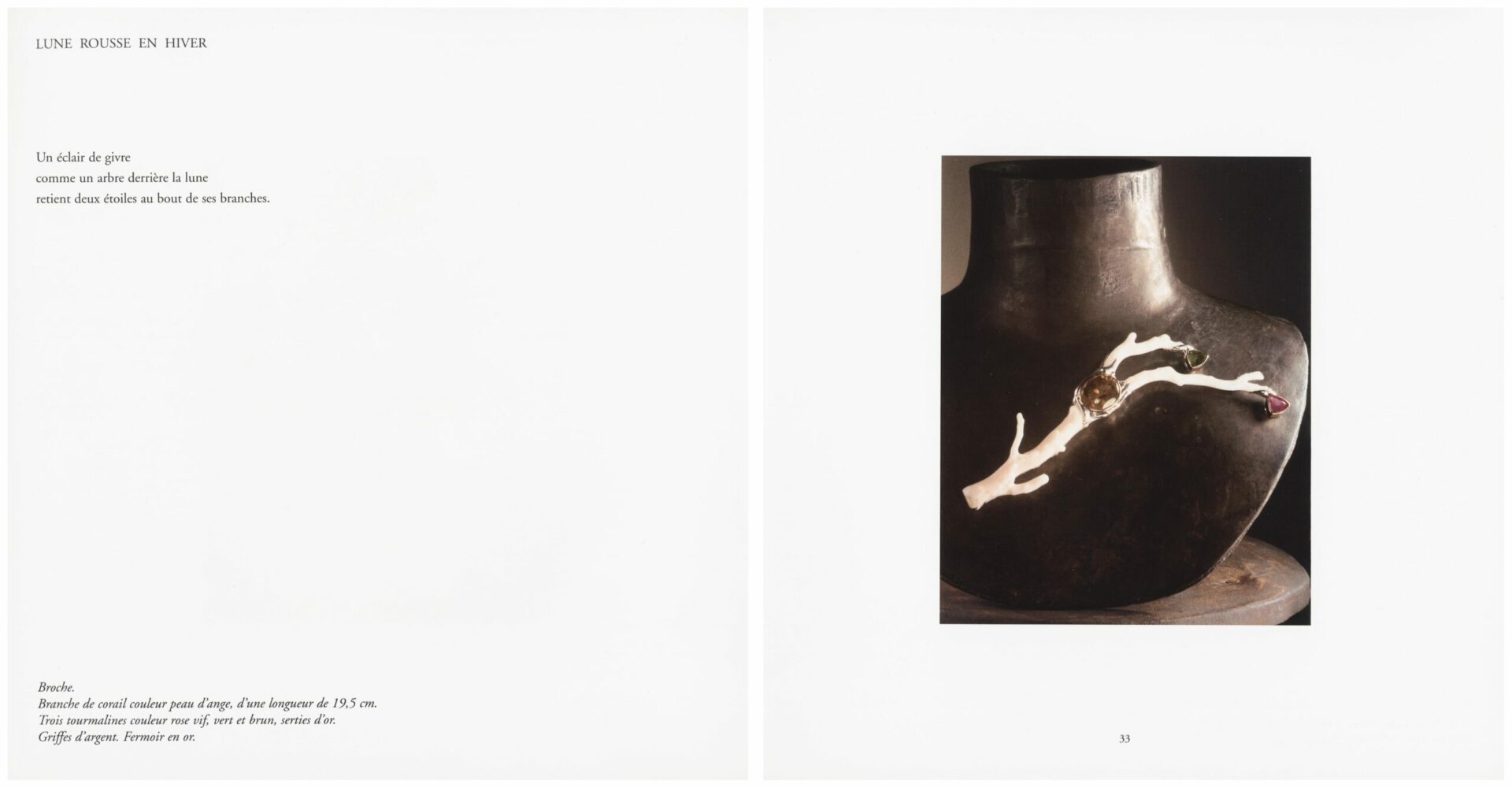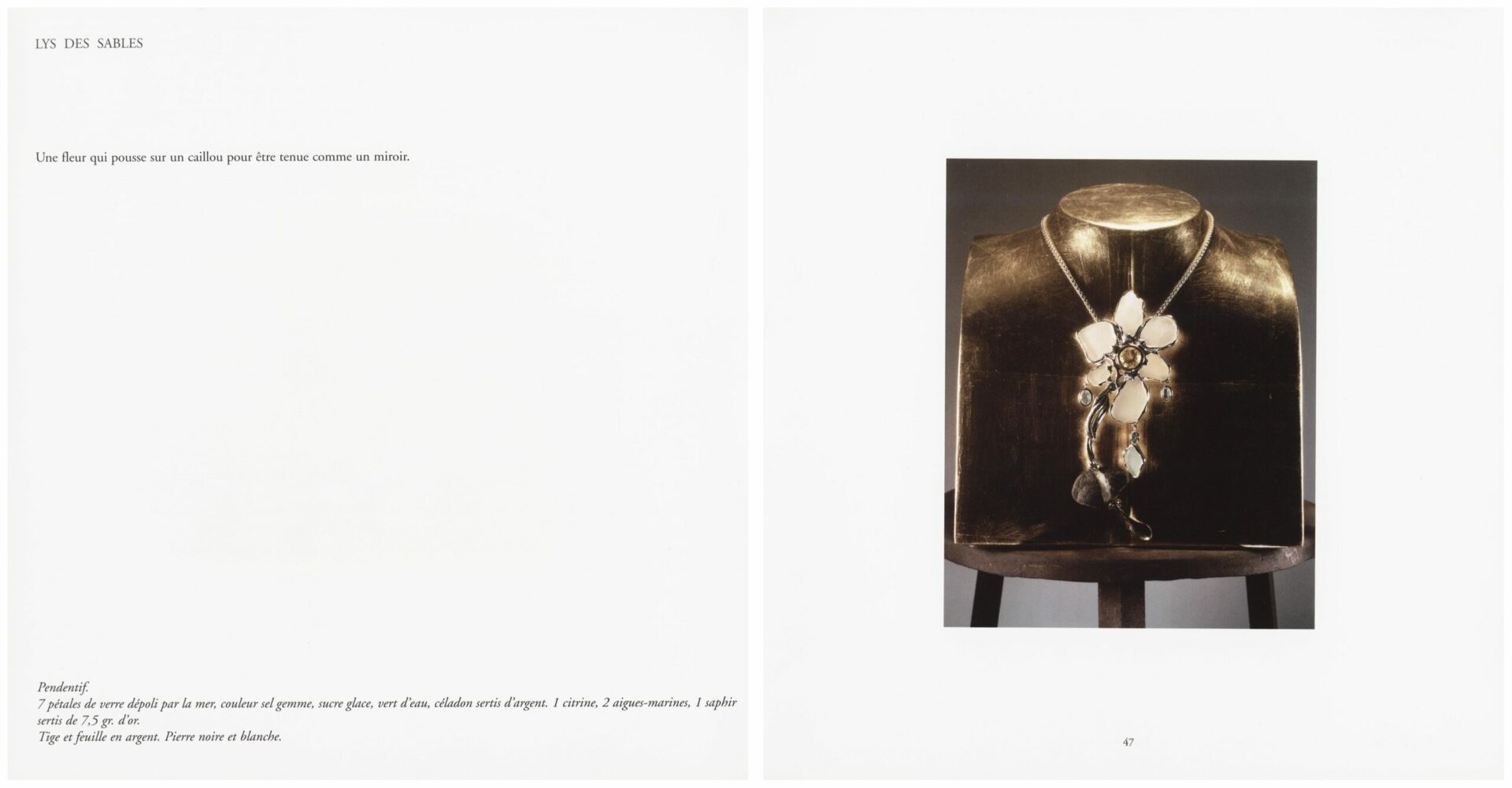2003 – “Bijoux”
2003,
Exhibitions
October 16th to December 16th, 2003.
Twenty or so pieces of jewellery. Defying the norms of conventional jewellery making, Annabelle used jewels like watercolour paints, in a way devoid of hierarchy. The result is a series of one-of-a-kind pieces, which combine materials rarely seen together, such as sea glass set in gold. As much art as jewellery, every necklace enjoys a bespoke bronze bust to hang from and each has its own story. They are modern talismans somewhere between adornments and works of art, not ornaments, but rather personal armours. Annabelle worked alongside award- winning writer and poet Marc Cholodenko to create poetic titles, such as Jules Verne’s Fish or the Intoxication of the Depths or The Candy Cane Empress, and tales, sometimes just snippets of tales, for every piece. Their collaboration was made into a limited edition catalogue for her exhibition Bijoux 2003 at Galerie Mougin in Paris.
Location: Gladys Mougin Gallery, Paris.
Painter, sculptor and photographer, known for her monumental installations, Annabelle d’Huart also appropriates the field of art in reduced scale for her jewelry creations. She is demolishing the traditional codes of jewelry making and creating a better way to extract a new vision of the beautiful from her assemblages. Is it because Annabelle d’Huart has traveled the world for a long time—gleaning from her random wanderings, here, a pearl of a strangely green color or a fragment of coral shaped like a winged Samothrace; there, the shell of a tortoise or a piece of stained glass—that her current work on jewelry seems like a quest? This is no “remembrance of things past,” but the search instead for an emotion that is both active and contemplative in the way it comes into contact with objects and forms of life. “I create jewelry toward which you must go to make it a part of yourself. Each of us is responding to a need, to a nature. In a world in which luxury is extremely codified and responds to norms dictated by financial conglomerates, I think its necessary to introduce a bit of mystery,” she explains in a childlike voice, while also confessing having spent years before feeling worthy of the identity of “artist.” And yet! This Parisian, who studied first at the Ecole Camondo and continued with art history in Florence, has never ceased to conceive of her work with that rare independence of mind characteristic of the great creators. Her journey began in New York, where she spent two years photographing American minimalist artists. She then detoured by way of Istanbul to produce a book on harems. She returned to Paris, where her partner of the time, the architect Ricardo Bofill, helped her gain a sensitivity to the tri-dimensional qualities of forms; then she wrote several books, while at the same time directing a research unit on the evolution of materials. In 1990, Annabelle burst into the world of painting with ATLANTIDE, a series of enormous gouaches on the theme of time and memory. With SONGES D’OR OU L’ORIGINE REVÉE, she investigated sculpture through a 4m-x-8m installation, composed of twenty three terracotta vase forms. This piece gave the impression of being suspended in a void. Beginning in 1991with TALISMAN, a “twenty-eight-day necklace” in ebony and solid silver symbolizing the phases of the moon, whose production had been entrusted to her by the Société des Amis du Musée d’Art Moderne (shown since that time by the Guggenheim Museum in New York and acquired by Maison Chanel), her approach to jewelry continues to arise from the same fervor for creation. On busts of bronze—specially conceived by the artist—she placed twenty-eight wonders of creativity and expertise. “Even if they aren’t worn, my jewelry must nevertheless be able to be looked at, and contemplated as a complete work of art.” Each element tells a story. A sort of mini-text whose plot and punctuations are revealed according to the materials that compose them. Precious matter, such as gold, silver, diamonds, sapphires and cultured pearls are used. Semiprecious stones, such as garnets, turquoises, aquamarines, amethysts or topazes; elements mottled by nature, such as pebbles, branches of coral, fragments of quartz or mica, or rosewood. From these heterogeneous assemblages, which are a priori antinomical to jewelry and smithing traditions, an idea of the beautiful, dominated above all by emotion and purity, has come forth. A branch of red coral on an assemblage of white coral, punctuated by gray and gilded pearls, serving as a miniaturized vision of the mythic coral reef of the Pacific. Blue sapphire set with gold in the shape of a fisheye and a luminescent spate of pearls, labradorites, aquamarines and garnets offer a playful interpretation, in the form of a necklace, of the decom Pression vertigo described by Jules Verne. Green pebbles are set with solid gold for a brooch representing a tree, drawn by the hand of a child; a glittering silver cross with pebbles covered in gold cloisonné evoke those sublimes medieval jewels on display at the Musée de Cluny. Twenty-three-carat morganite, encrusted with amethysts, with petals of rose mica set with silver, pink beryl and silver shafts create a necklace in homage to the asphodel or carrot flower. Aquamarine, gold, silver, rosewood and glass pebbles make a necklace referencing “the casting of gold on black water,” in recollection of the paintings of David Hockney. As expressively wrought on the back as on the front, Annabelle d’Huart’s jewelry astonishes and inspires by the discordant blend of influences that permeate it; and all and all, by its manner of serving as reflector of our inner worlds.
PHILIPPE DAYAN







































